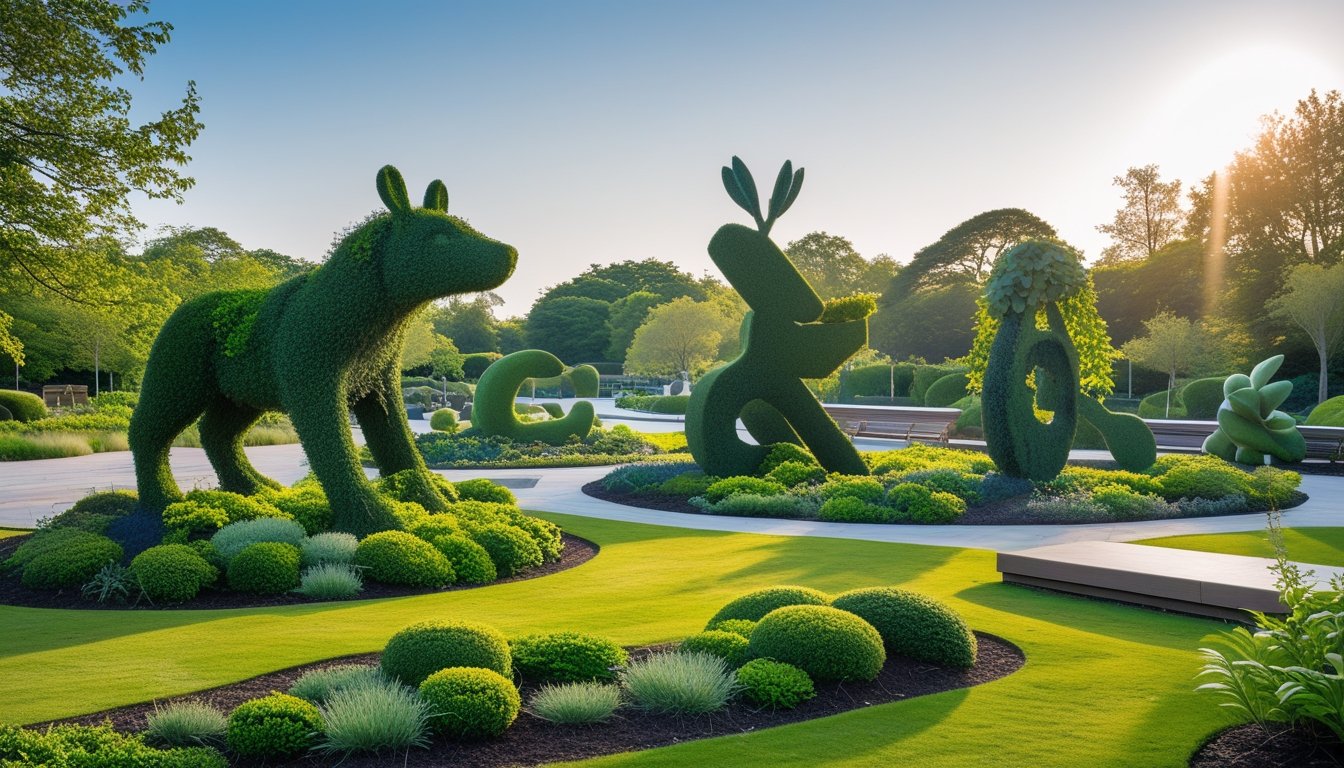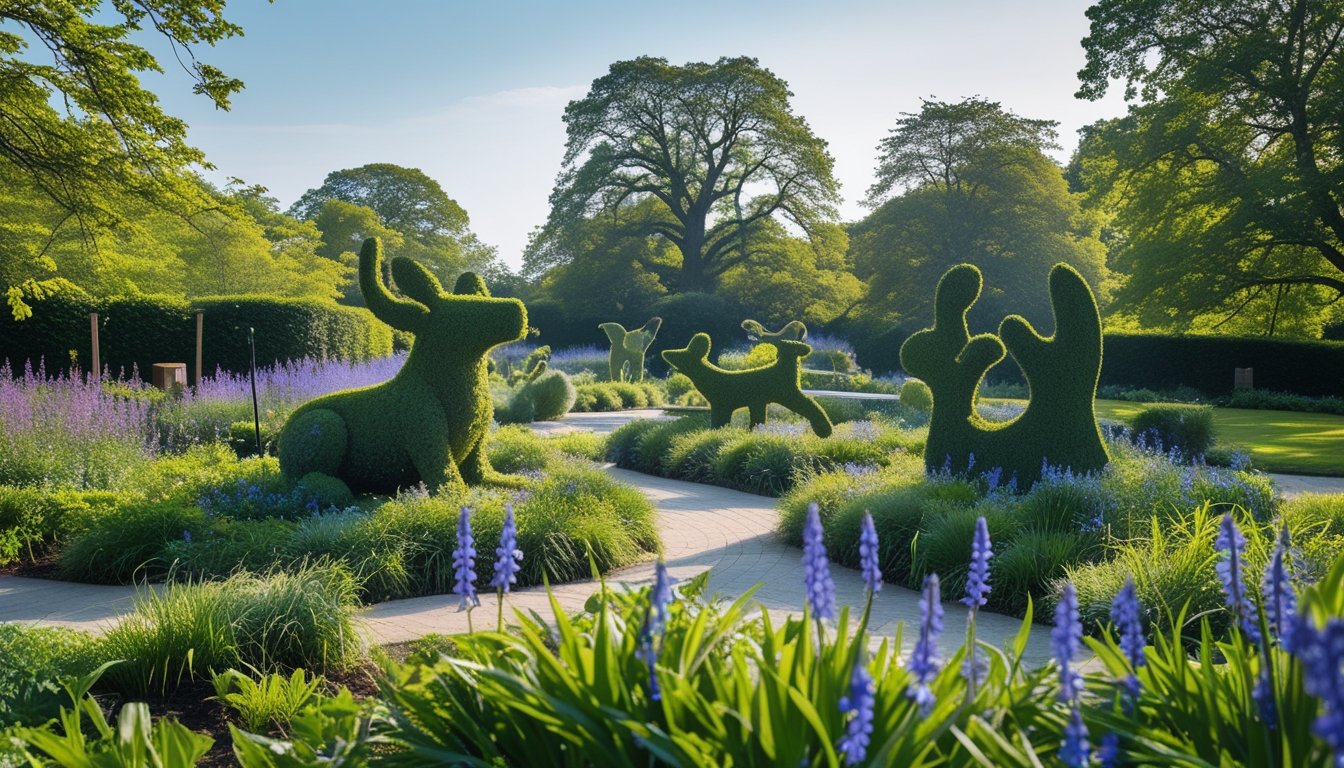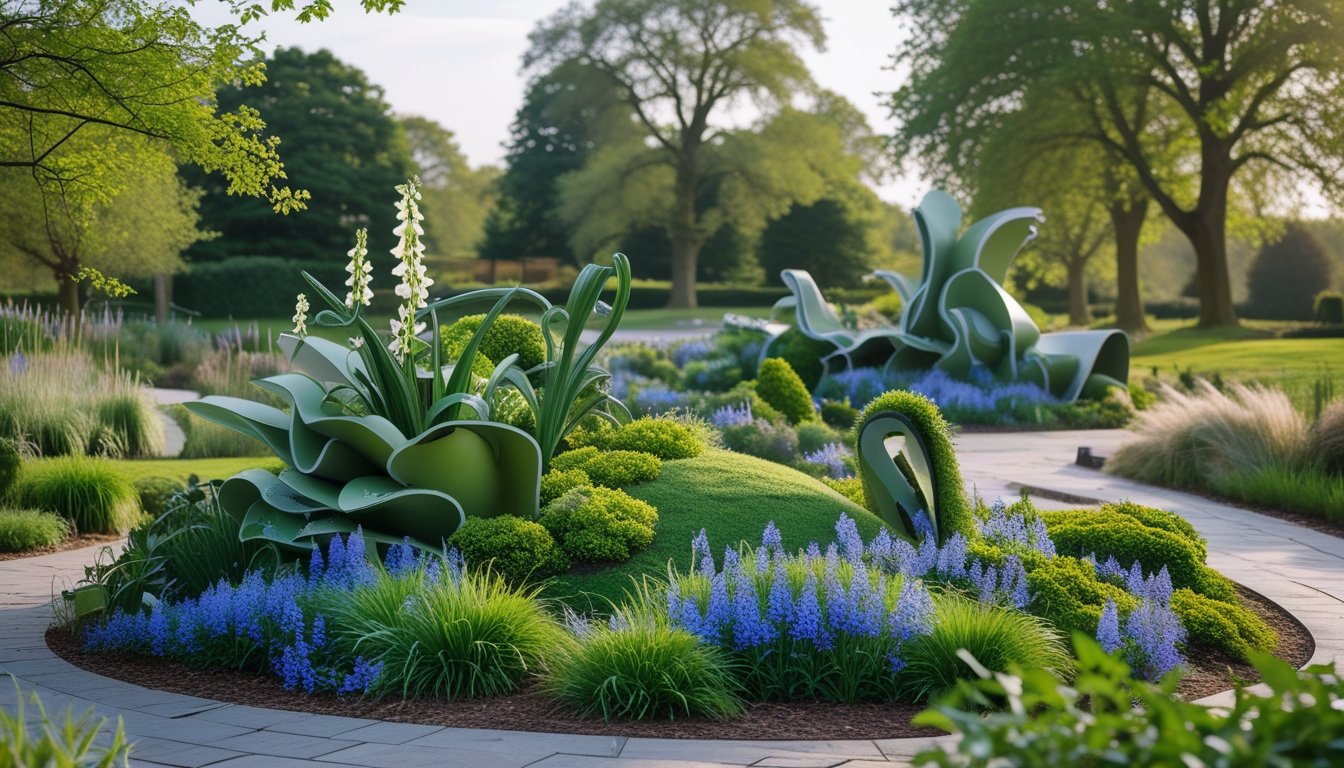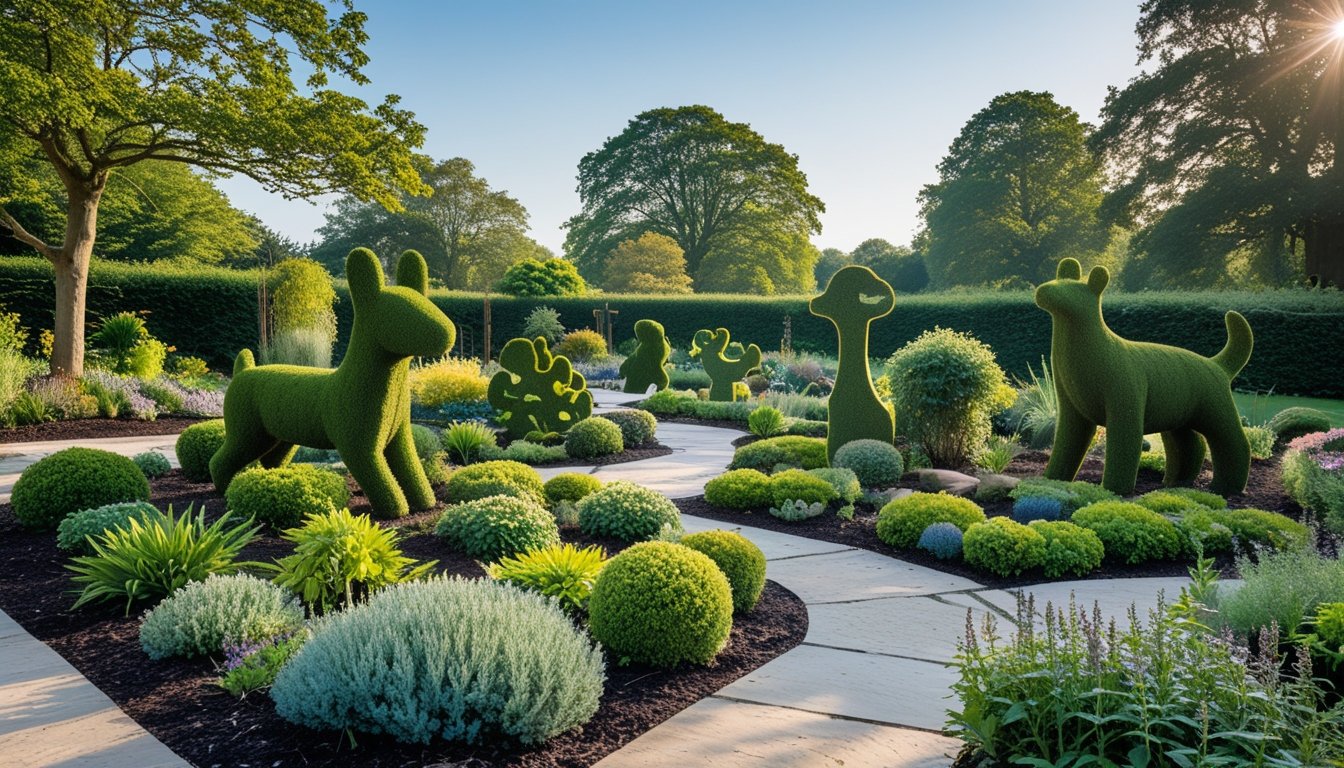Late updated: 18 Aug 2025 14:08
Written by: Emily Thornton
Enhancing UK Outdoor Spaces With Native Plant Sculptures: Transforming Landscapes
The allure of a well-designed garden lies not only in its beauty but also in how it can reflect our personalities and support the local ecosystem. Sculptures crafted from native UK plants present a unique way to enhance outdoor spaces by combining ecological benefits with artistic flair. By integrating sculptures made from native plants, we create gardens that are both eco-friendly and visually captivating.

The practice of using native plants in sculptural designs offers gardeners the chance to showcase creativity while embracing sustainability. Plant sculptures can serve as focal points within garden designs, drawing the eye and creating an interactive experience. They not only enrich the aesthetic appeal of our gardens but also provide vital habitats and resources for local wildlife.
As we explore this intriguing approach, we uncover opportunities for creativity and sustainability that traditional garden strategies might not offer. Native plant sculptures are at the forefront of modern garden design, reflecting a growing trend towards environmentally-responsible practices. Engaging with this technique connects us profoundly with nature, transforming our outdoor spaces into personal havens that resonate with both art and ecology.
Key Takeaways
- Native plant sculptures combine art and eco-friendliness.
- They enhance garden aesthetics and support local wildlife.
- This approach encourages creativity and sustainable practices.
The Impact of Native Plant Sculptures on UK Outdoor Spaces

Incorporating native plant sculptures into UK outdoor spaces significantly enhances biodiversity, supports local wildlife, and improves soil health. By integrating these artistic plant arrangements, we also promote pollination and water conservation while contributing to the beauty of our gardens and parks.
Enhancing Biodiversity and Supporting Local Wildlife
Native plant sculptures play a vital role in boosting biodiversity by providing habitats and food sources for local wildlife. These sculptures are crafted with species that thrive in the UK climate, attracting insects, birds, and small mammals. As these creatures interact with the sculptures, they form a complex web of life that strengthens the local ecosystem.
The presence of diverse plant species in these sculptures can offer shelter for various animals. This diversity is essential for maintaining ecological balance. Native plant sculptures become small ecosystems themselves, supporting different life forms crucial for a healthy environment.
Fostering Pollinators Through Native Species
Our native plant sculptures also positively affect pollinators such as bees, butterflies, and other insects. These species are drawn to the native flora that mirrors their natural habitats. By providing a continuous supply of nectar and pollen, we actively support pollinator populations needed for the reproduction of many plant species.
By choosing native species, we ensure that pollinators are not just attracted but also sustained throughout different seasons. This results in an increase in pollination activities, which benefits the surrounding flora. Encouraging these interactions helps maintain robust plant populations in our gardens and beyond.
Improving Soil Health and Promoting Water Conservation
Constructing native plant sculptures contributes to healthier soil by enhancing its structure and nutrient content. Native plants are often better adapted to local soil conditions, which improves their resilience and sustainability. Furthermore, their root systems can help prevent erosion and increase soil porosity, allowing water to permeate more effectively.
This adaptation is particularly useful for water conservation. Native plants typically require less irrigation as they are accustomed to the local rainfall patterns. As we incorporate these plant sculptures into our landscapes, we not only save water but also reduce maintenance efforts. Our commitment to these practices supports a self-sustaining environment that thrives with minimal intervention.
Designing and Implementing Native Plant Sculptures

Creating native plant sculptures involves thoughtful selection and integration of UK-specific flora to enhance biodiversity and sustainability. Aligning with ecological standards and aesthetic goals is paramount for both visual impact and ecological harmony.
Selecting Suitable Native UK Plants for Sculptures
Choosing native UK plants is vital to ensure that the sculptures blend seamlessly into the local environment and promote native biodiversity. Plants like Hawthorn (Crataegus monogyna) and Silver Birch (Betula pendula) are resilient and well-adapted to the UK's climate. These plants provide both structure and seasonal interest, crucial for sustaining visual appeal year-round. When planning the foundation of our sculptures, understanding microclimates in the garden space informs plant selection. It is essential to use species that thrive in similar soil conditions and light.
Integrating Wildflowers, Grasses, and Hedgerows
Incorporating wildflowers, such as species found in wildflower meadows, adds a layer of colour and biodiversity to our sculptures. Utilising grasses like Deschampsia cespitosa complements the visual composition with textures that contrast with woody plants. Hedgerows offer a structured backdrop, contributing to the natural aesthetics while supporting wildlife. Mixing perennials with carefully selected annual wildflowers can enhance the temporal dynamics of the installation, attracting pollinators and nurturing local ecosystems. This integration requires careful grouping to ensure compatibility with the environmental demands of each plant.
Sustainable Garden Design and Pruning for Longevity
Sustainable garden design principles are essential when implementing plant sculptures. Consistent pruning maintains the desired shape and health of the plants, preventing overgrowth and encouraging new shoots, vital for long-term sustainability. Consider water conservation techniques, such as installing rainwater catchment systems, to reduce reliance on external water sources. A thoughtful combination of plants ensures they support each other while minimising resource competition. Pruning not only aids in preserving the intended design but also enhances plant health, ensuring that the sculptures remain vibrant and engaging over time.
Mitigating the Risks of Invasive Species
Managing the risks of invasive species is crucial to protect the ecological balance when designing plant sculptures. By focusing on native flora, we can reduce the chances of introducing species that may disrupt local ecosystems. It's essential to monitor and swiftly remove any invasive plants that could establish themselves. Establishing clear guidelines can help maintain the ecological harmony these sculptures aim to embody. Awareness and proactive management ensure that our creative endeavours do not inadvertently harm the surrounding environment or biodiversity.
Frequently Asked Questions

Our discussion on native plant sculptures highlights crucial practices for integrating them into UK gardens, demonstrating their value in enhancing biodiversity and improving wildlife habitats. We explore the practical aspects of selecting suitable plants and maintaining these sculptures through changing seasons, focusing on their educational benefits.
What are the best practices for integrating native plant sculptures into UK gardens?
Integrating native plant sculptures requires an awareness of the local climate and soil conditions. It's crucial to select plant species that thrive in these environments. Planning the sculpture's placement to maximise sunlight and protect it from harsh wind ensures better growth. Incorporating a variety of plant heights and textures can create a dynamic visual appeal.
How do native plant sculptures contribute to biodiversity in the UK?
These sculptures enhance biodiversity by offering varied habitats for insects, birds, and small mammals. Native plants are adapted to local ecosystems and provide the necessary resources these creatures need to thrive. Their presence can support pollinators, help in pest control, and increase the resilience of local ecosystems.
Can native plant sculptures in urban areas improve local wildlife habitats?
Yes, they can. In urban areas, native plant sculptures create green pockets that serve as crucial refuges for wildlife amidst concrete landscapes. These areas act as stopover points for birds, provide food sources for butterflies and bees, and help in improving the overall ecological health of cities.
What are some renowned UK native plants suitable for creating outdoor sculptures?
Renowned native plants like the common yarrow (Achillea millefolium), foxglove (Digitalis purpurea), and wild marjoram (Origanum vulgare) are excellent choices. These species are hardy and aesthetically pleasing, which makes them ideal for sculpture. They bring colour and diversity while being low-maintenance, making them suitable for sculptural applications.
How to maintain native plant sculptures through the changing British seasons?
Maintenance involves seasonal pruning and monitoring soil conditions. During winter, protective measures like mulching can help preserve root systems. In spring and summer, regular watering and removing dead foliage ensures healthy growth. Observing and responding to pest activities promptly is also essential for maintaining plant health throughout the year.
What are the potential benefits of having native plant sculptures in educational outdoor spaces?
Native plant sculptures in educational settings offer hands-on learning opportunities about ecology and the environment. They serve as living laboratories where students can observe plant-animal interactions. Such installations raise awareness about conservation efforts and inspire a deeper appreciation for biodiversity in both pupils and educators.
